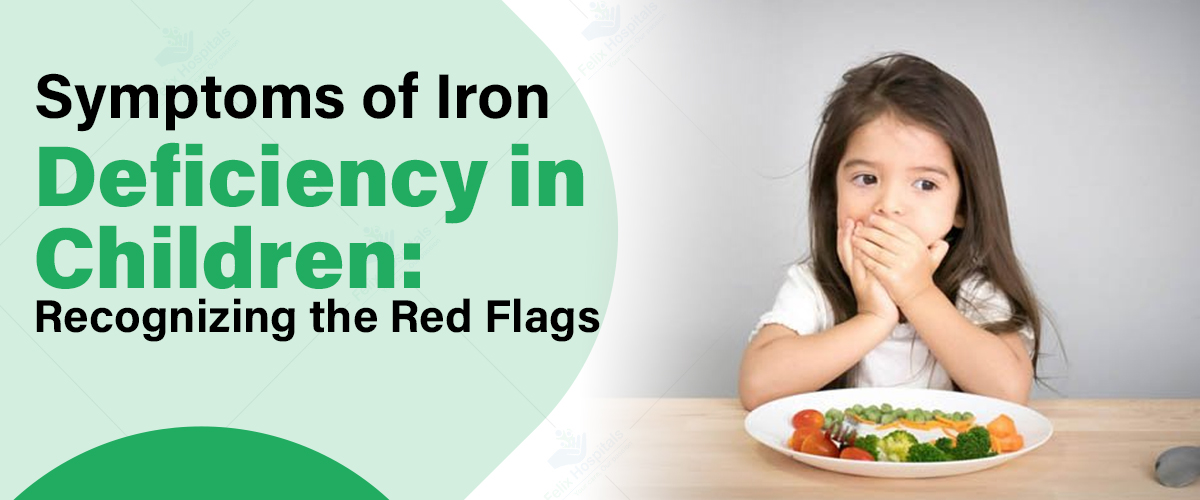
Subscribe to our

Iron deficiency anemia is a common health problem in children. If your child is experiencing a lack of energy, it may be due to iron deficiency and requires consultation from your pediatrician. In this blog, we will discuss important topics such as the symptoms of iron deficiency in newborn and what exactly iron deficiency is. To learn more about anemia and receive the best care for your child, visit the best Paediatric Hospital in Noida. Let’s see what our expert pediatrician Dr Vishrut Singh has to say about this.
If your child is suffering from iron deficiency, contact Felix Hospital in Noida at +91 9667064100.
Iron-deficiency anemia occurs when there isn't enough iron in the body. This condition results in a lower number of red blood cells (RBCs) than usual. RBCs contain hemoglobin, a protein that carries oxygen throughout the body. The body needs iron to produce hemoglobin. Without sufficient iron, the production of hemoglobin and red blood cells decreases, leading to anemia.
Iron deficiency anemia may go unnoticed in its early stages because symptoms are often mild or non-specific. However, as the deficiency progresses, it can lead to more pronounced signs and symptoms such as:
- Why: Poor blood circulation and reduced oxygen delivery to tissues can weaken nails.
- Example: Nails becoming fragile, prone to breaking or splitting.
These symptoms can vary in severity depending on the degree of anemia and individual health factors. If you suspect you or someone else may have anemia based on these symptoms, it's essential to consult a healthcare provider for proper diagnosis and treatment.
Dr. Niraj Kumar is a seasoned pediatrician and neonatology specialist with over 11 years of experience. His expertise includes infant and child nutrition, childhood infections, limping child, child development disease treatment, thyroid disease in newborn, growth and development evaluation/management, and vaccination/immunization.
Dr. Prabhat Kumar, with 9 years of experience, specializes in infectious diseases, general pediatrics, and growth and development. He is well-versed in treating various childhood illnesses and teenage health issues.
Dr. Divya Gupta, a pediatrician and pediatric surgeon with 12 years of experience, focuses on thyroid disease in newborn, growth and development evaluation/management, vaccination/immunization, child vaccination, and newborn care. She offers expert consultation for childhood illnesses, immunizations, and vaccinations.
Dr. Vishrut Singh, with over 11 years of experience, is a dedicated pediatrician specializing in diagnosing and treating various pediatric conditions. He provides personalized care and tailored treatment plans to enhance patient health and meet individual needs.
Contact Felix Hospital in Noida today at +91 9667064100 for expert care and treatment.
Iron deficiency anemia in newborns can manifest through a variety of symptoms, often subtle at first but becoming more pronounced as the deficiency worsens. Recognizing these signs early and seeking medical attention is crucial for proper diagnosis and treatment. Maintaining a balanced diet rich in iron and consulting with healthcare professionals can help manage and prevent iron deficiency. If you observe any of these symptoms in your newborn, seek comprehensive care and guidance from the top Child Specialist in Noida.
1.) What happens when your iron is low?
When your iron levels are low, your body can't produce enough hemoglobin, the protein in red blood cells that carries oxygen throughout your body. This can lead to symptoms such as fatigue, weakness, dizziness, shortness of breath, pale skin, brittle nails, and cold hands and feet. If left untreated, iron deficiency can progress to iron-deficiency anemia, a more severe condition that requires medical attention.
2.) How to fix iron deficiency?
To fix iron deficiency, you can:
3.) What drinks are high in iron?
Drinks themselves are generally not high in iron, but some can help improve iron absorption:
4.) How to boost iron immediately?
To boost iron levels immediately:
5.) What food is highest in iron?
6.) How to check iron levels at home?
At-home tests for checking iron levels include:
7.) What is a normal iron level?
Normal iron levels can vary, but generally:
It's important to get tested by a healthcare provider to understand your specific levels.
8.) Are eggs high in iron?
Eggs contain some iron, but they are not considered a high-iron food. One large egg has about 0.9 mg of iron. While eggs are nutritious, other sources like red meat, seafood, legumes, and leafy greens provide higher iron content.
9.) Is 7 iron levels low?
Yes, a serum iron level of 7 mcg/dL is considered very low and indicates iron deficiency. Normal levels range from 60-170 mcg/dL, so a level of 7 mcg/dL would typically be associated with significant iron deficiency anemia and would require medical evaluation and treatment.